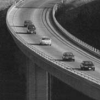
Study Cites Deficient Roads as Leading Highway Hazard
More than half of U.S. highway fatalities are related to deficient roadway conditions--a substantially more lethal factor than drunk driving, speeding, or non-use of safety belts--according to a study released Wednesday by the Pacific Institute for Research and Evaluation (PIRE), an independent, non-profit transportation safety research organization. Ten roadway-related crashes occur every minute (5.3 million a year) and also contribute to 38 percent of non-fatal injuries, the report found.
In revealing that deficiencies in the roadway environment contributed to more than 22,000 fatalities and cost the nation more than $217 billion annually, PIRE concluded that making the roadway environment more protective and forgiving is essential to reducing highway fatalities and costs.
"If we put as much focus on improving road safety conditions as we do in urging people not to drink and drive, we'd save thousands of lives and billions of dollars every year," said principal study author Dr. Ted Miller. "Safer drivers and safer cars remain vitally important, but safer roadways are critical to saving lives, preventing injuries, and reducing costs."
Titled "On a Crash Course: The Dangers and Health Costs of Deficient Roadways," the study found the $217 billion cost of deficient roadway conditions dwarfs the costs of other safety factors, including: $130 billion for alcohol, $97 billion for speeding, or $60 billion for failing to wear a safety belt. Indeed, the $217 billion figure is more than three-and-one-half times the amount of money government at all levels is investing annually in roadway capital improvements--$59 billion, according to the Federal Highway Administration.
The report concluded that roadway-related crashes impose $20 billion in medical costs; $46 billion in productivity costs; $52 billion in property damage and other resource costs; and $99 billion in quality of life costs, which measure the value of pain, suffering, and loss of enjoyment of life by those injured or killed in crashes and their families. The report also found that crashes linked to road conditions cost American businesses an estimated $22 billion at a time when many firms are struggling. According to the report, crashes linked to road conditions cost taxpayers more than $12 billion every year.
"Recent concerns about swine flu pale in comparison to the number of crash victims I treat," said Dr. Jared Goldberg, an emergency room physician in Alexandria, Va. "In medical terms, highway fatalities and injuries have reached epidemic proportions, and efforts to prevent further spread of this plague are essential. In the absence of a true vaccine to defend ourselves, fixing dangerous roads would help prevent traffic crashes from occurring in the first place."
"On a Crash Course" identifies ways transportation officials can improve road conditions to save lives and reduce injuries. For example, immediate solutions for problem spots include: replacing non-forgiving poles with breakaway poles, using brighter and more durable pavement markings, adding rumble strips to shoulders, mounting more guardrails or safety barriers, and installing better signs with easier-to-read legends. The report also suggested more significant road improvements, including: adding or widening shoulders, improving roadway alignment, replacing or widening narrow bridges, reducing pavement edges and abrupt drop offs, and clearing more space adjacent to roadways.
"Although behavioral factors are involved in most crashes, avoiding those crashes through driver improvement requires reaching millions of individuals and getting them to sustain best safety practices," Miller said. "It is far more practical to make the roadway environment more forgiving and protective."
The report also analyzed crash costs on a state-by-state basis. The 10 states with the:
- Highest total cost from crashes involving deficient road conditions are (alphabetically): Alabama, California, Florida, Georgia, Illinois, New York, North Carolina, Pennsylvania, Tennessee, and Texas.
- Highest road-related crash costs per million vehicle miles of travel are: Alabama, Arkansas, Hawaii, Idaho, Kentucky, Louisiana, Mississippi, South Carolina, Tennessee, and West Virginia.
- Highest road-related crash costs per mile of road are: California, Connecticut, District of Columbia, Florida, Hawaii, Maryland, Massachusetts, New Jersey, New York, and South Carolina.
PIRE conducted the study on behalf of the Transportation Construction Coalition (TCC), which hosts the full report, complete state-by-state data and other research findings at www.transportationconstructioncoalition.org. TCC members are calling on Congress to provide significant, dedicated funding for roadway safety improvements and to develop programs that encourage states to invest even more. The federal law that governs transportation funding will expire this fall, and congressional committees are now in the process of drafting successor legislation, PIRE noted.